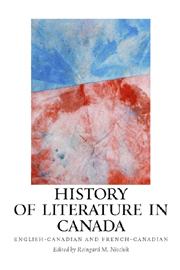Book contents
- Frontmatter
- Contents
- Acknowledgments
- Introduction: Writing a History of Literature in Canada
- I Beginnings
- II The Literature of New France, 1604–1760
- III The Literature of British Canada, 1763–1867
- IV From the Dominion to the Territorial Completion of the Nation, 1867–1918
- V The Modern Period, 1918–1967
- VI Literature from 1967 to the Present
- 21 Sociopolitical and Cultural Developments from 1967 to the Present
- 22 English-Canadian Literary Theory and Literary Criticism
- 23 The English-Canadian Novel from Modernism to Postmodernism
- 24 The English-Canadian Short Story since 1967: Between (Post)Modernism and (Neo)Realism
- 25 English-Canadian Poetry from 1967 to the Present
- 26 Contemporary English-Canadian Drama and Theater
- 27 Canons of Diversity in Contemporary English-Canadian Literature
- 28 Literature of the First Nations, Inuit, and Métis
- 29 The Quebec Novel
- 30 The French-Canadian Short Prose Narrative
- 31 French-Canadian Poetry from 1967 to the Present
- 32 Orality and the French-Canadian Chanson
- 33 Drama and Theater from the Révolution tranquille to the Present
- 34 Transculturalism and écritures migrantes
- 35 The Institutionalization of Literature in Quebec
- Further Reading
- Notes on the Contributors
- Index
28 - Literature of the First Nations, Inuit, and Métis
from VI - Literature from 1967 to the Present
Published online by Cambridge University Press: 12 September 2012
- Frontmatter
- Contents
- Acknowledgments
- Introduction: Writing a History of Literature in Canada
- I Beginnings
- II The Literature of New France, 1604–1760
- III The Literature of British Canada, 1763–1867
- IV From the Dominion to the Territorial Completion of the Nation, 1867–1918
- V The Modern Period, 1918–1967
- VI Literature from 1967 to the Present
- 21 Sociopolitical and Cultural Developments from 1967 to the Present
- 22 English-Canadian Literary Theory and Literary Criticism
- 23 The English-Canadian Novel from Modernism to Postmodernism
- 24 The English-Canadian Short Story since 1967: Between (Post)Modernism and (Neo)Realism
- 25 English-Canadian Poetry from 1967 to the Present
- 26 Contemporary English-Canadian Drama and Theater
- 27 Canons of Diversity in Contemporary English-Canadian Literature
- 28 Literature of the First Nations, Inuit, and Métis
- 29 The Quebec Novel
- 30 The French-Canadian Short Prose Narrative
- 31 French-Canadian Poetry from 1967 to the Present
- 32 Orality and the French-Canadian Chanson
- 33 Drama and Theater from the Révolution tranquille to the Present
- 34 Transculturalism and écritures migrantes
- 35 The Institutionalization of Literature in Quebec
- Further Reading
- Notes on the Contributors
- Index
Summary
BEFORE THE 1960S, published writing by Aboriginal authors in Canada was sparse and virtually unknown. The English and French missionaries had introduced writing into the numerous originally oral Aboriginal cultures, and Aboriginal-authored written histories, travel accounts, and autobiographies by authors such as George Copway (1818–1869) and Peter Jones (1802–1856; both Ojibway) exist from the nineteenth century onwards. Yet with the notable exception of Mohawk-English poet and performer E. Pauline Johnson (1861–1913; Tekahionwake), whose work received widespread attention at the end of the nineteenth and beginning of the twentieth century and continues to inspire contemporary Aboriginal writers such as Joan Crate and Beth Brant, what was perceived as Aboriginal literature in Canada were mostly Aboriginal stories collected and published by non-Aboriginal ethnographers as “folklore,” “myths,” and tales. Okanagan author Jeannette Armstrong recounts a telling childhood experience from as late as a “day in 1965 when a cousin of mine pointed to the road from our one-room school on the reserve and said, ‘There's the Indian guy who wrote a book!’ All of us rushed to the window to look at him, awestruck.… That experience exemplifies how remote the idea of a real live ‘Native’ person writing a ‘book’ was at that time” (Armstrong 2001, xv). While there were indeed few Aboriginal writers at the time, the scarcity of Aboriginal writing available in print was also the result of Aboriginal authors being excluded from the Canadian publishing industry and book market, a situation that was to change only slowly in the decades to come.
- Type
- Chapter
- Information
- History of Literature in CanadaEnglish-Canadian and French-Canadian, pp. 413 - 428Publisher: Boydell & BrewerPrint publication year: 2008



